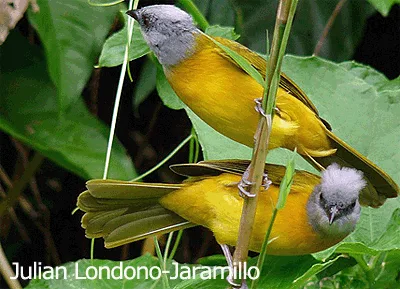 Grey-headed Tanager Grey-headed Tanager (Eucometis penicillata) [order] PASSERIFORMES | [family] Thraupidae | [latin] Eucometis penicillata | [UK] Grey-headed Tanager | [FR] Tangara a tete grise | [DE] Graukopf-Tangare | [ES] Sigua Hormiga Bachaquera | [NL] Amazone-tangare Subspecies
Physical charateristicsA small crest on a entirely grey head with a grey pale throat. Upeerparts plive green and underparts briht yellow. Listen to the sound of Grey-headed Tanager [audio:http://www.aviflevoland.nl/sounddb/G/Grey-headed Tanager.mp3]
RangeLatin America : Southeast Mexico to Southcentral Brazil and North Paraguay HabitatIts natural habitats are subtropical or tropical moist lowland forests, subtropical or tropical swamps, and heavily degraded former forest This tanager is, in Surinam, mainly seen in swampy forests in the coastal area, often low in the trees. Prefers the lower strata of humid second growth woodland and forest, ReproductionNest is a low cup built in thick undergrowth, clutch size is two eggs. Feeding habitsFollows army ants in small groups or foragres 1-10 mter up in forest for insects. ConservationThis species has an extremely large range, and hence does not approach the thresholds for Vulnerable under the range size criterion (Extent of Occurrence <20,000 km2 combined with a declining or fluctuating range size, habitat extent/quality, or population size and a small number of locations or severe fragmentation). The population trend appears to be stable, and hence the species does not approach the thresholds for Vulnerable under the population trend criterion (>30% decline over ten years or three generations). The population size is very large, and hence does not approach the thresholds for Vulnerable under the population size criterion (<10,000 mature individuals with a continuing decline estimated to be >10% in ten years or three generations, or with a specified population structure). For these reasons the species is evaluated as Least Concern.  MigrationSedentary throughout range Distribution map |
]]>
